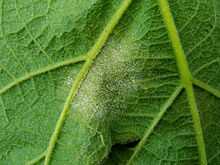Plasmopara viticola
| Plasmopara viticola | |
|---|---|
 | |
| Scientific classification | |
| Kingdom: | Chromalveolata |
| Phylum: | Heterokontophyta |
| Class: | Oomycota |
| Order: | Peronosporales |
| Family: | Peronosporaceae |
| Genus: | Plasmopara |
| Species: | P. viticola |
| Binomial name | |
| Plasmopara viticola (Berk. & M.A. Curtis) Berl. & De Toni, (1888) | |
| Synonyms[1][2][3][4] | |
| |
Plasmopara viticola, the causal agent of grapevine downy mildew, is a heterothallic oomycete that overwinters as oospores in leaf litter and soil. In the spring, oospores germinate to produce macrosporangia, which under wet conditions release zoospores. Zoospores are splashed by rain into the canopy, where they swim to and infect through stomata. After 7–10 days, yellow lesions appear on foliage. During favorable weather, the lesions sporulate and new secondary infections occur.[5]
Description
Plasmopara viticola, also known as the grape downy mildew is considered to be the most devastating grape pathogen in North America and Europe. This oomycete was originally observed in the United States about 1834 and is most abundantly found in the northern and midwestern areas of the United States. Shortly after this first observation the pathogen was introduced to the European countries where it played a devastating role in the yield and production of their grapes, and consequently their wine. France was among the first of the European countries to gain experience in dealing with the pathogen. Within just a few years of the pathogen's introduction the French attempted to graft American root stock to their own vines in order to produce a more resistant strain of grape. Depending on the year, production of grapes in France has been estimated to be at a loss of 50% or more.[6] Because of numbers and results like these, downy mildew has been considered the most devastating disease of a filamentous pathogen to affect European vineyards.[7]
Symptoms cover a fairly large range depending mostly on the host. Common symptoms include necrosis of the stem or shoot, discoloration including brown spotting (lesions) and yellowish-green tips of the leaves. Grapes may exhibit sporangium or mycelium, appearing as a white to gray coat on the outer surface.
Downy mildew requires optimum conditions to reproduce and infect. A warm, moist, and humid environment is required. Studies in Sicily have shown optimum time for oospore germination is between the end of February and the middle of March.[8] With this understanding, if fungicides are used just before optimum conditions occur, they have proven to be an effective control method of the pathogen. Other control methods include propering watering, and a good location where the plant can receive continual sunlight.
Phytoalexins production
Delta-viniferin is a grapevine phytoalexin produced following fungal infection by P. viticola.[9]
References
- ↑ Hesler, R. Lex, 1917, Manual of Fruit Diseases, Macmillan Company, New york city, page 237
- ↑ Salzar, D.M. 1994 Enfermedades Criptogamicas:El mildiu 1.Sem. Vitiv. 2.487, 1051-1053
- ↑ Perez-Salas J. 1988 Defensa contra el mildiu: Caracteristics de la enfermedad Sem. Vitiv. 2. 191, 3385-3387
- ↑ Burruano S. and Ciofalo G. (1990) Studio della dinamica di germinazione delle oosporei plasmopara viticola (Berk et Curt) Berl. et De toni. Notiziario delle Mallattie delle piante, ser.3, 38:274-286
- ↑ (Kennelly et al., 2006).
- ↑ (Hesler, 1917)
- ↑ (Perez-salas, 1998; Perez Martin, 1989; Salazar, 1994)
- ↑ (Burruano and Ciofalo, 1990)
- ↑ Timperio, Anna Maria; d’Alessandro, Angelo; Fagioni, Marco; Magro, Paolo; Zolla, Lello (2012). "Production of the phytoalexins trans-resveratrol and delta-viniferin in two economy-relevant grape cultivars upon infection with Botrytis cinerea in field conditions". Plant Physiology and Biochemistry 50 (1): 65–71. doi:10.1016/j.plaphy.2011.07.008. PMID 21821423.
Bibliography
- Perez Marin, J.L. 1989 Mildiu dela vid victic. Enol. 2,22-25.
- Salzar, D.M. 1994 Enfermedades Criptogamicas:El mildiu 1.Sem. Vitiv. 2.487, 1051-1053
- Hesler, R. Lex, 1917, Manual of Fruie Diseases, page 237, Macmillan Company, New yorik
- Salas J. 1988 Defensa contra el mildiu: Caracteristicas de la enfermedad sEM. vITIV. 2.191, 3385- 3387.
- 059.2005.01208.x Population genetic structure of Plasmopara viticola after 125 years of colonization in European vineyards
External links
- Index Fungorum
- USDA ARS Fungal Database
- Plasmopara viticola
- Contributions of oospore inoculum to epidemics of grapevine downy mildew (Plasmopara viticola)